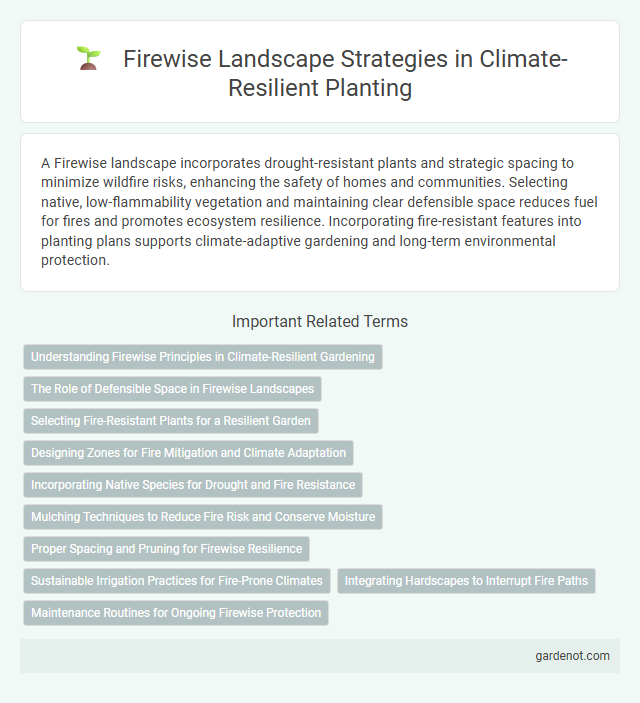A Firewise landscape incorporates drought-resistant plants and strategic spacing to minimize wildfire risks, enhancing the safety of homes and communities. Selecting native, low-flammability vegetation and maintaining clear defensible space reduces fuel for fires and promotes ecosystem resilience. Incorporating fire-resistant features into planting plans supports climate-adaptive gardening and long-term environmental protection.
Understanding Firewise Principles in Climate-Resilient Gardening
Firewise landscape design incorporates strategic plant selection, spacing, and maintenance to reduce wildfire risks in climate-resilient gardening. Emphasizing drought-tolerant, fire-resistant species alongside regular removal of dead vegetation mitigates fire spread and promotes ecosystem stability. Integrating these principles enhances garden resilience against increasing fire hazards driven by climate change.
The Role of Defensible Space in Firewise Landscapes
Defensible space in Firewise landscapes involves strategic vegetation management to reduce wildfire fuel loads around structures, enhancing property protection and firefighter safety. Creating buffer zones through selective pruning, removal of dead plants, and maintaining appropriate spacing between trees and shrubs significantly decreases the risk of fire spreading. This approach integrates fire-resistant plants and hardscape features to create survivable spaces that improve community resilience against wildfires.
Selecting Fire-Resistant Plants for a Resilient Garden
Selecting fire-resistant plants is essential for creating a Firewise landscape that minimizes wildfire risk. Species such as lavender, California lilac, and succulents contain high moisture content and low resin levels, reducing flammability around homes. Incorporating these fire-adapted plants can enhance garden resilience, slow fire spread, and protect property during wildfire events.
Designing Zones for Fire Mitigation and Climate Adaptation
Designing Firewise landscapes involves creating distinct zones with fire-resistant vegetation and strategically spaced plants to reduce wildfire risk and enhance climate adaptation. Incorporating drought-tolerant native species and maintaining defensible space ensures resilience against extreme weather patterns and prolonged dry spells. Proper zoning integrates fuel breaks and irrigation systems, optimizing fire mitigation while supporting plant health under changing climatic conditions.
Incorporating Native Species for Drought and Fire Resistance
Incorporating native species in Firewise landscapes enhances drought tolerance and fire resistance by leveraging plants adapted to local climatic and soil conditions. Native plants typically have deep root systems and high moisture retention, reducing flammable material and promoting ecosystem resilience. This approach supports biodiversity while minimizing irrigation needs and wildfire risks in climate-resilient planting strategies.
Mulching Techniques to Reduce Fire Risk and Conserve Moisture
Mulching techniques in Firewise landscaping play a critical role in reducing fire risk by creating a moisture-retentive barrier that inhibits ignition from ember attacks and surface flames. Organic mulches such as bark chips and composted leaves help conserve soil moisture, enhance soil health, and promote plant resilience during drought conditions. Applying a 2-3 inch layer of mulch around plants while maintaining clear zones free of flammable materials significantly enhances fire resistance and supports sustainable landscape management.
Proper Spacing and Pruning for Firewise Resilience
Maintaining proper spacing between plants and regular pruning of dead or overgrown branches significantly reduces fire hazards in a Firewise landscape. Strategic placement of vegetation minimizes fuel continuity, creating natural firebreaks that slow the spread of wildfires. These practices enhance climate-resilient planting by improving plant health and reducing wildfire intensity around homes.
Sustainable Irrigation Practices for Fire-Prone Climates
Firewise landscapes incorporate drought-tolerant plants and mulching techniques that reduce water use while maintaining soil moisture, crucial for fire-prone climates. Sustainable irrigation practices include drip irrigation and soil moisture sensors to optimize water delivery, minimizing runoff and evaporation. These methods enhance plant health and resilience, reducing wildfire fuel and conserving water resources efficiently.
Integrating Hardscapes to Interrupt Fire Paths
Firewise landscapes incorporate strategically placed hardscapes such as gravel paths, stone patios, and concrete driveways to disrupt the continuity of combustible vegetation and reduce fire spread. These non-flammable surfaces create defensible spaces by acting as physical barriers that interrupt fuel continuity, effectively minimizing fire intensity near structures. Integrating hardscapes in fire-prone areas is a crucial component of climate-resilient planting strategies aimed at enhancing landscape fire resistance.
Maintenance Routines for Ongoing Firewise Protection
Regular maintenance routines are essential for sustaining a Firewise landscape and minimizing wildfire risks. Removing dead vegetation, pruning trees to maintain adequate canopy spacing, and clearing debris from gutters and walkways reduce fuel loads and improve fire resistance. Consistent watering and monitoring plant health also promote resilience, ensuring that the landscape remains a barrier against wildfire spread.
Firewise landscape Infographic

 gardenot.com
gardenot.com